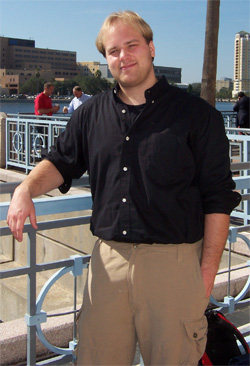
My name is David Kunzman. While this website is largely devoted to sharing photography and artwork, neither of these things are directly related to my professional career. Currently, I am a software engineer working in the Hardware Technologies group at Apple.
While studying for my PhD at the University of Illinois at Urbana-Champaign (UIUC), my main area of study was parallel computing and related runtime systems. More specifically, I focused in on heterogeneous computing. After graduate school, I worked at Intel, where I did similar work. I have a separate page covering my research while I was at UIUC.
Heterogeneous computing involves using non-standard processing cores in conjunction with more traditional processing cores to perform an overall computation. In my case, this involved a combination of traditional x86 host cores, Cell processors (PlayStation 3s and IBM Cell Blades), NVIDIA GPGPUs (NVIDIA graphics cards using CUDA for general purpose computation), and the Knights line of products from Intel.
The main focus of all this parallel and heterogeneous computing was focus in the area of
scientific computing. During my time at UIUC, I was simultaneously a member of both the
Parallel Programming Lab (PPL) ![]() in the
Computer Science (CS) Department
in the
Computer Science (CS) Department ![]() ,
and the
Theoretical and Computational Biophysics Group (TCBG)
,
and the
Theoretical and Computational Biophysics Group (TCBG) ![]() in the
Beckman Institute for Advanced Science and Technology
in the
Beckman Institute for Advanced Science and Technology ![]() .
.
As a member of the Parallel Programming Lab, I contributed to the development of the
Charm++ programming model ![]() .
Charm++ has been used to develop a wide range of scientific simulations scaled up to run on many
of the largest super computers in the world. Scientific applications developed using Charm++
include applications related to molecular dynamics, computational cosmology, pandemic/epidemic
simulations, and more.
.
Charm++ has been used to develop a wide range of scientific simulations scaled up to run on many
of the largest super computers in the world. Scientific applications developed using Charm++
include applications related to molecular dynamics, computational cosmology, pandemic/epidemic
simulations, and more.
As part of the TCBG group, I contributed to the development of the high performance computing
(HPC) application
NAnoscale Molecular Dynamics (NAMD) ![]() .
NAMD is molecular dynamics application used to simulate biomolecular systems at the atomic scale.
NAMD is NIH funded and built on top of the Charm++ programming model.
.
NAMD is molecular dynamics application used to simulate biomolecular systems at the atomic scale.
NAMD is NIH funded and built on top of the Charm++ programming model.
After leaving Intel in 2015, I joined Apple, where I am currently working in the Hardware Technologies group. Unfortunately, I cannot discuss much of what I am currently working on at Apple, so this page largely focuses on my background before working at Apple.
